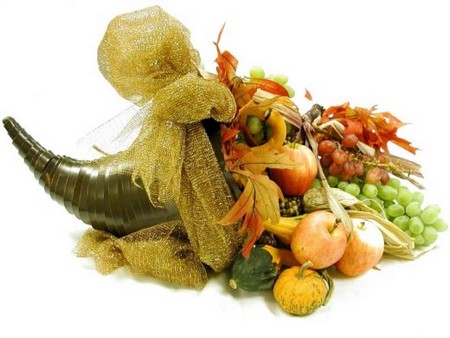History of the Cornucopia
When you sit down to a Thanksgiving feast, it’s likely your eyes take in an attractive centerpiece on the table called a cornucopia. Fresh flowers, fruits and vegetables fill and spill out of the horn-shaped woven basket. Nicknamed the “horn of plenty,” the word cornucopia originated in Greek myth. After reading about this humble decoration’s beginnings, you may look at the cornucopia in a different way the next time you see one.
Zeus Creates the Cornucopia
Two stories concern the cornucopia’s origins. The first begins with Zeus, the greatest of all the Greek gods. Cronus, his father, wanted to kill Zeus, so his mother Rhea hid him in Crete to protect him. The king of Crete had several daughters who raised him, and their goat provided milk for the child. When Zeus grew older he broke off one of the goat’s horns and gave them the magic power to fill up with whatever the owner of the horn desired. Zeus gave the horns to the king’s daughters to thank them for caring for him. According to legend, whoever owned the horn would never go hungry.

An alternate story involves the goat giving Zeus one of her horns in reverence. Zeus repays her by placing her image in the sky. We know the image as the constellation Capricorn.
Hercules Makes the Cornucopia Instead
The second story in Greek mythology concerns Hercules’s role in creating the cornucopia. A feud erupted between the mighty Hercules and the river-god Achelous. The two competed for the love of Dejanira, a young woman of breath-taking beauty. The two fought in a colossal wrestling match and Hercules began to get the better of Achelous. Achelous, a shape-shifter, changed into a serpent and then into a bull in an effort to gain leverage against Hercules. Hercules broke off one of Achelous’s horns, and when he did the river changed course. The water-nymphs came upon the horn in the river and treated the horn as a sacred object. They filled the horn with flowers and took care of it. Later Copia, the Goddess of Plenty, adopted the horn. Hercules married Dejanira and they reared a family.
Artist Renderings of the Cornucopia
Mythological beings and deities illustrate a theme in classical paintings, and the cornucopia became a popular design element. Artists often painted the curved goat’s horn filled with fruit and grain, and thus it came to symbolize wealth and plenty. Tyche, the goddess of riches and abundance, also became associated with the cornucopia. It also became the emblem for several other deities.
Modern design for cornucopias usually involves the use of it as a fall decoration. A favorite of florists, they often act as a vessel for containing bright, decorative flowers, fruits, gourds and many other decorative ideas that make it a pretty table ensemble.
The cornucopia symbolizes riches and plenty in some folklore, art and mythology, so the decoration rightfully belongs on the table at which you plan to have a meal while enjoying the company of family and friends.
The Meaning of the Word Cornucopia
The cornucopia has a close association with Thanksgiving, but people considered it symbolic before the holiday existed. The word originated in 1508 and comes from the Latin cornu, meaning horn, and copia, meaning plenty.

References
Zeus
http://www.thanksgiving-day.org/cornucopia.html
Hercules
http://www.flowershopnetwork.com/pages/newsletter/NewsletterOctober2005.php
Latin
http://dictionary.reference.com/browse/cornucopia
